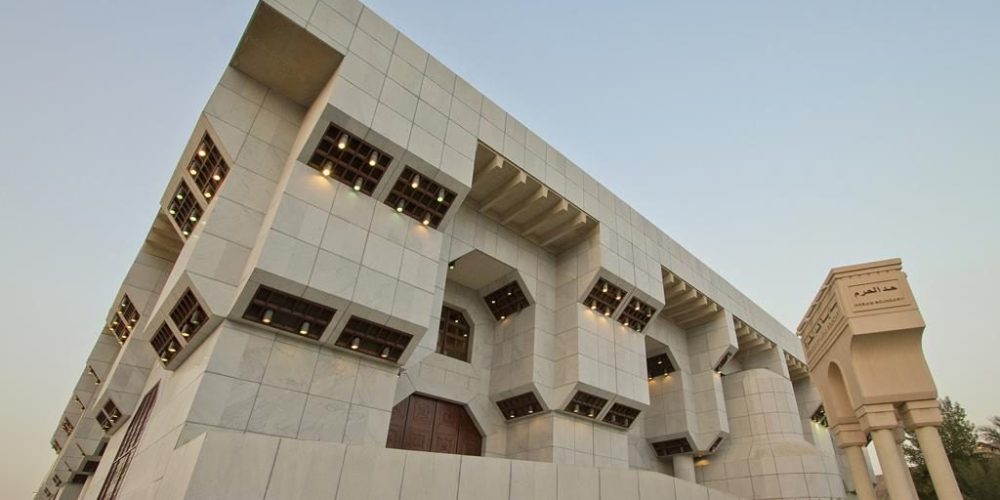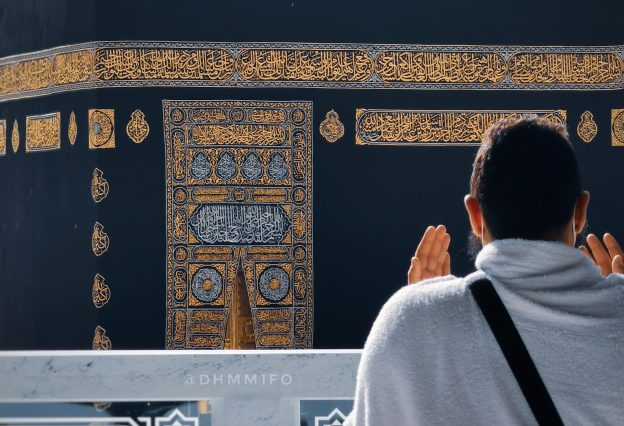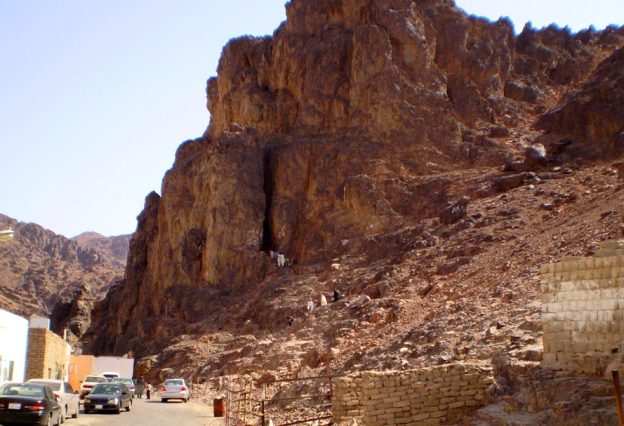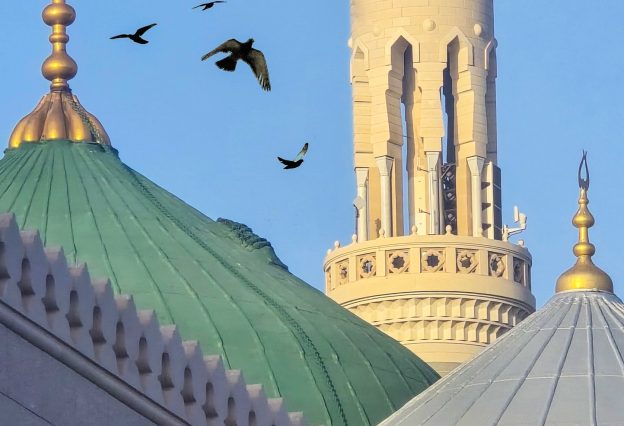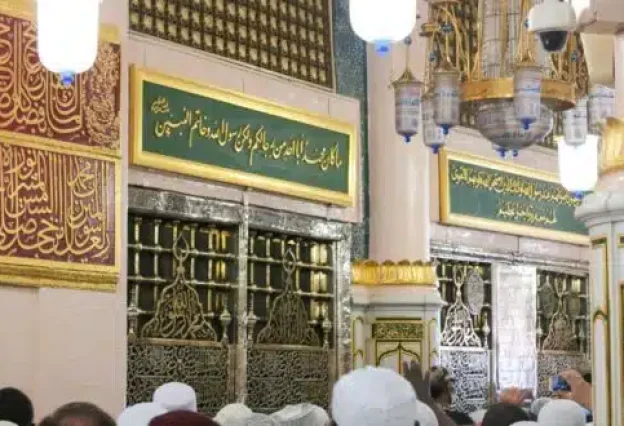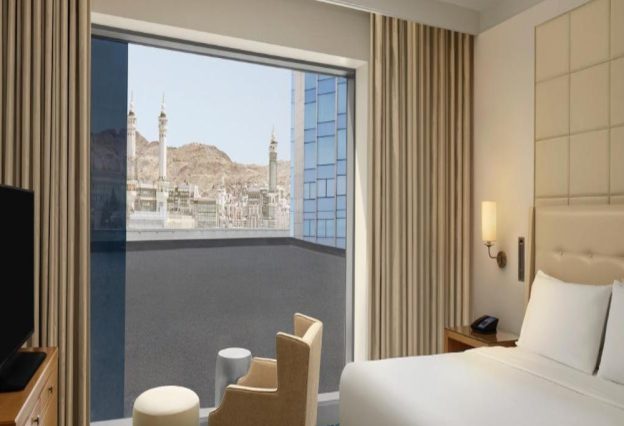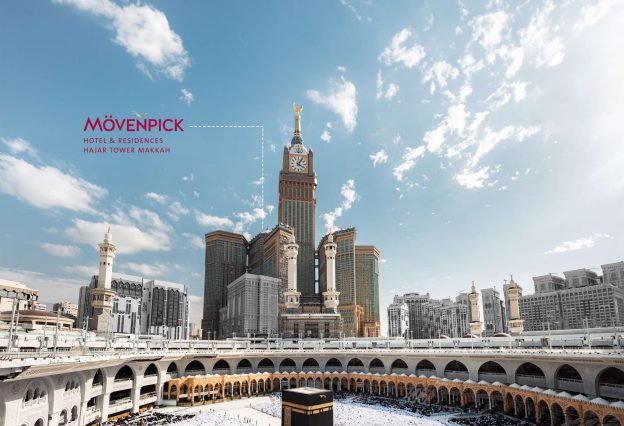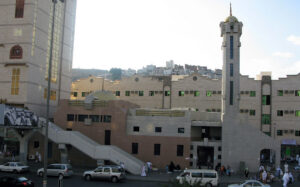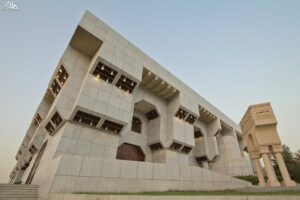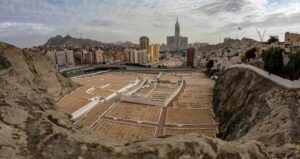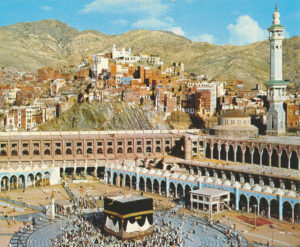Masjid Aisha (Arabic: عائشة مسجد), also known as Masjid al-Taneem (مسجد التنعيم), is a mosque located at the site where Aisha I was instructed by the Prophet ﷺ to enter into Ihram in order to perform Umrah during the Farewell Pilgrimage. It is the nearest and most convenient location to enter into Ihram for those residing within the boundaries of the Haram, and those intending to perform an additional Umrah.
Masjid Aisha Location
Masjid Aisha is located at a distance of 7.5 kilometres from Masjid Al-Haram. It is on the route from Makkah al-Mukarramah to Madinah al-Munawwarah, commonly referred to as Tareeq al-Hijrah. Renowned for its exceptional architecture and distinct construction, it stands out as one of the prominent landmarks of Makkah.
Names and Significance of the Mosque
The mosque is known as Masjid Aisha as it was erected at the very site where the Mother of the Believers, Aisha bint Abu Bakr J, initiated her Ihram for Umrah during the Farewell Hajj in the year 9 AH. During the pilgrimage, she expressed her disappointment at being unable to perform Umrah due to menstruation. She said:
I got my menses and could not perform Tawaf around the Kaaba. So when it was the night of Hasba (i.e. when we stopped at al-Muhassab), I said, ‘O Allah’s Messenger ﷺ! Everyone is returning after having performed Hajj and Umrah, but I’m returning after having performed only the Hajj.’ He said, ‘Didn’t you perform Tawaf around the Kaaba the night we reached Makkah?’ I replied in the negative. He said, ‘Go with your brother to Taneem and assume the Ihram for Umrah.
[Narrated in Sahih al-Bukhari]
The Prophet ﷺ called her brother, Abdur Rahman ibn Abu Bakr I, and told him to accompany her on her Umrah. She narrates:
The Prophet ﷺ called Abdur Rahman and said, ‘Leave the Haram with your sister and let her assume Ihram for Umrah. After both of you have finished the Tawaf, I will be waiting here for you.’ We came back at midnight and the Prophet ﷺ asked us, ‘Have you finished?’ I replied in the affirmative. He announced the departure, and the people set out for the journey, with some of them having performed the Tawaf of the Kaaba before the morning prayer. After that, the Prophet ﷺ set out for Madinah.
[Narrated in Sahih al-Bukhari]
She also narrates her journey to Taneem:
I rode behind Abdur Rahman on his camel. I recall that as I was young, I felt sleepy and my head would fall and my face would touch the back of the saddle. It was a very hot night, so much so that my head covering would fall off my neck. My brother would hold my leg and hit it against the camel. We reached Taneem where I started the Umrah in lieu of the Umrah that people performed after entering Makkah.
[Narrated in Ahmad]
Masjid Aisha is also known as Masjid al-Taneem, named after two mountains situated on either side of it. Additionally, the mosque is sometimes referred to as the Umrah Mosque as it is a starting point for residents of Makkah and pilgrims intending to perform Umrah again.
The Development of Masjid Aisha
The mosque was initially constructed by the Emir of Makkah at the time, Abu Abbas Abdullah ibn Muhammad, under the Abbasid Caliph al-Mutawakkil in the year 240 AH (854).
Over time, significant portions of the mosque were demolished and subsequently reconstructed, leading to its expansion. During the era of Saudi rule, the mosque was rebuilt, with King Fahd bin Abdulaziz overseeing its reconstruction for 100 million riyals. The total area of the mosque, including its facilities, now spans 84,000 square meters and can accommodate approximately 15,000 worshippers.
The mosque itself spans an area of 6,000 square meters and features two minarets. Adjacent to the mosque, there are numerous facilities available to cater to the needs of pilgrims, including a large parking area designated for buses, taxis, and private cars. Additionally, there are restrooms, shower facilities and changing rooms. There are also small stalls and vendors outside that sell essential items such as Ihram garments and other items for Umrah.
Is Masjid Ayesha a Miqat?
Masjid Aisha is a Miqat point for those already inside the Haram area. This applies to residents in this area as well as pilgrims wishing to perform an additional Umrah. As well as Masjid Aisha, there are several other places where pilgrims inside the Haram area can enter into Ihram. These are:
- Adaat Laban – On the road to Yemen, 11 kilometres (7 miles) away from Makkah.
- Wadi Nakhla – On the road to Iraq, 11 kilometres (7 miles) away from Makkah.
- Arafat – On the road to Ta’if, close to Masjid Nimra in Arafat, 11 kilometres (7 miles) away from Makkah.
- Ji’ranah – Masjid al-Ji’ranah, located about 14 kilometres (9 miles) away from Makkah.
- Hudaibiyah – Masjid al-Hudaibiyah, on the road to Jeddah, about 16 kilometres (10 miles) away from Makkah.
Please note that if you are coming to perform Umrah beyond the Haram boundaries, you must enter into Ihram before crossing the designated Miqat boundaries.
Taxi Fare from Haram to Masjid Ayesha
Taxis stationed near Masjid al-Haram offer transportation to Masjid Aisha and back. For pilgrims seeking to reach Masjid Aisha from Masjid al-Haram, taxis are conveniently accessible near the mosque.
The journey typically takes approximately 20-30 minutes. The round trip, which involves a 15-minute pause for changing into Ihram and offering two raka’ahs of salah, generally takes around 1 hour and 15 minutes to complete. The taxi driver will wait for you while you get into the Ihram.
The round-trip taxi fare is typically around 60 riyals. However, during peak periods such as Ramadan and the Hajj season, the fare may increase to 100 riyals or more due to high demand. One-way trips generally cost around 40 riyals.
You may also opt to ride share with others, which will reduce the overall fare per person.
How to go to Masjid Ayesha from Haram by Bus
To reach Masjid Aisha from Masjid al-Haram by bus, you can catch bus number 12 from Terminal 1, Jabal Alka’bah. This bus stop is approximately a 15-20 minute walk from Masjid al-Haram. The fare for a one-way trip to Masjid Aisha is 4 riyals. Additionally, buses are available at Masjid Aisha to transport you back to the Haram.
Other Historical Sites Near Masjid Aisha
Grave of Maymuna bint al-Harith
About 15 minutes away (16 kilometres) from Masjid Aisha, along the road to Madinah, lies the grave of Maymuna bint al-Harith J, the wife of Prophet Muhammad ﷺ. She was laid to rest beneath a tree, where she got married to the Prophet ﷺ.
Visiting the grave and making du’a for the blessed soul of Maymuna bint al-Harith is a noble practice.
If you intend to perform this ziyarah, you can easily catch a taxi from Masjid Aisha. While some taxi drivers may not be familiar with the exact location of the grave, others will be. You should be able to find a taxi driver who can take you to it.
Khubayb ibn Adiy
Approximately two hundred meters south of Masjid Aisha lies the site where the great companion Khubayb ibn Adiy was martyred.
According to historical accounts, during the sixth year after the Hijrah, Prophet Muhammad ﷺ dispatched a group of companions to the Banu Lahyan tribe to propagate Islam among their people. The group of companions were instead attacked by the tribe, resulting in the martyrdom of all but three of them: Khubayb, Zayd bin al-Dathinnah and Abdullah ibn Tariq M. The surviving companions were later executed.
In the moments preceding his execution, Khubayb was asked whether he would trade his life for the life of the Prophet Muhammad ﷺ. He refused, expressing his love and loyalty towards the Prophet ﷺ. Before his execution, Khubayb requested to perform two raka’ahs of salah. After completing his prayer, he addressed the people, indicating that his prolonged prayer was not out of fear of death. He then recited couplets expressing his willingness to sacrifice his life for the sake of Allah and His Messenger ﷺ.
A small tower was erected at the site of Khubayb’s martyrdom, serving as a symbolic marker. However, it was demolished in the year 1377 AH (1957).
Masjid al-Taneem Photos
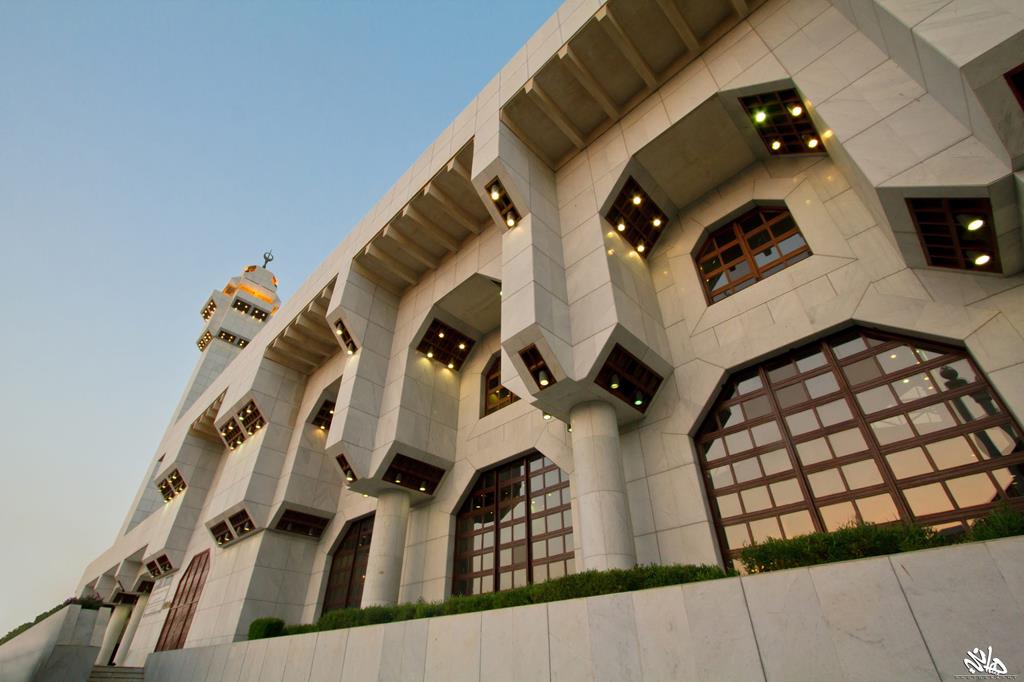
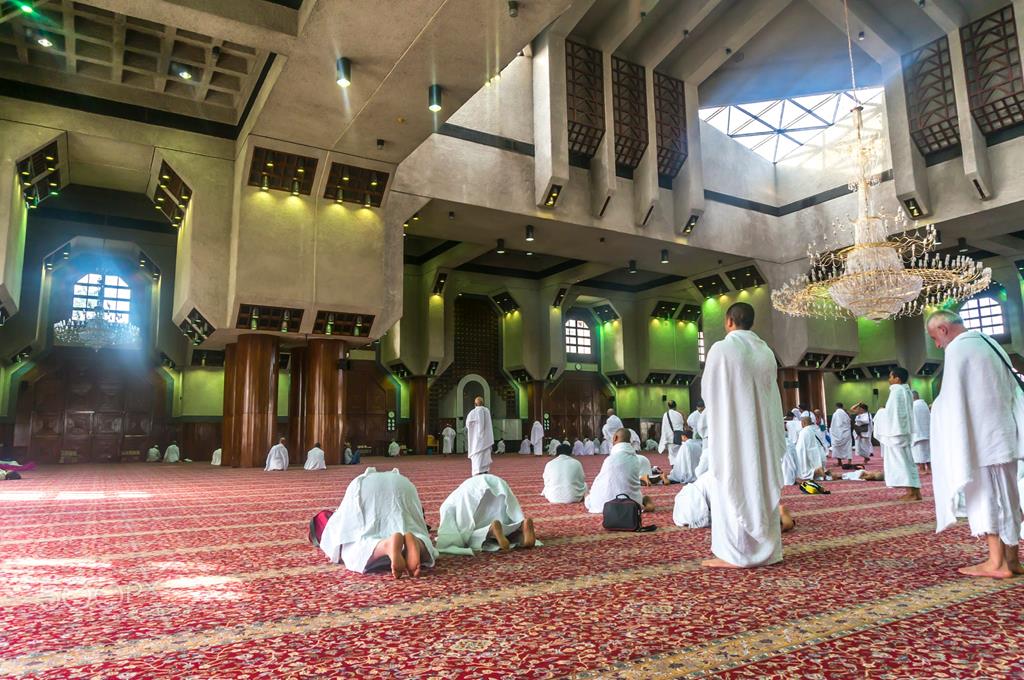
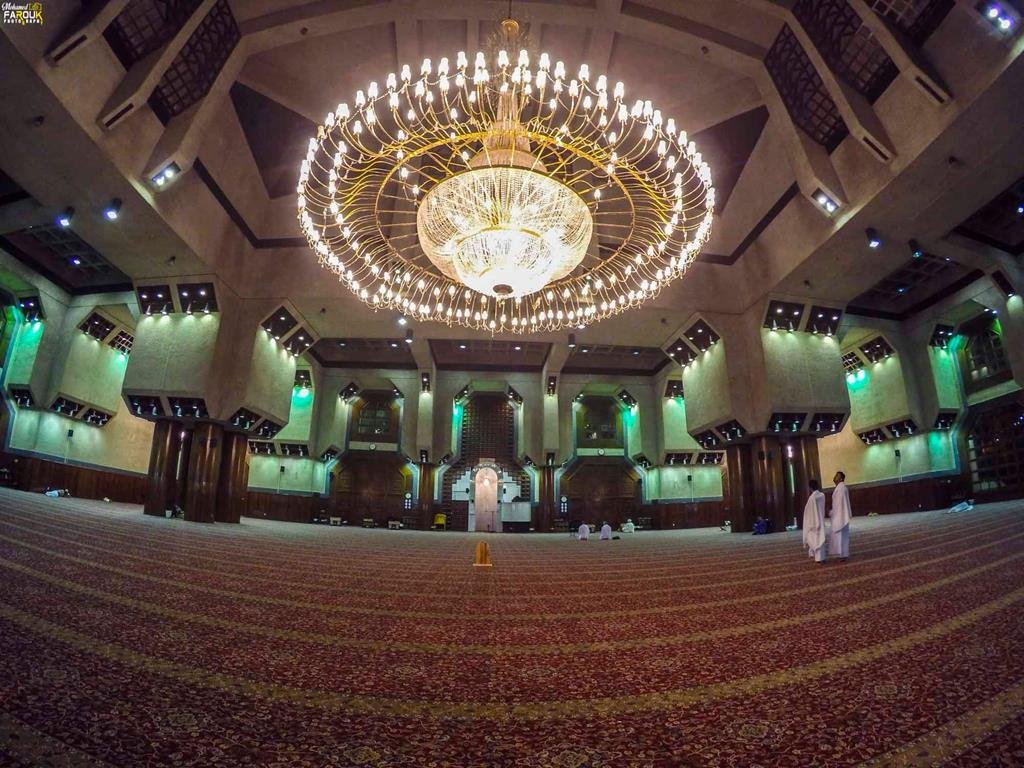
Source: https://hajjumrahplanner.com/masjid-aisha/

